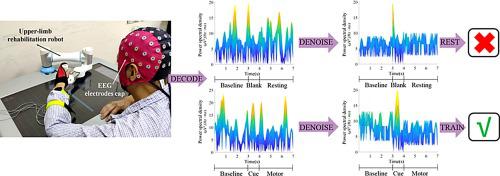Journal of Neuroscience Methods ( IF 3 ) Pub Date : 2020-08-15 , DOI: 10.1016/j.jneumeth.2020.108909 Tianyu Jia 1 , Ke Liu 2 , Chao Qian 1 , Chong Li 1 , Linhong Ji 1

|
Background
Rehabilitation robots integrated with brain-machine interaction (BMI) can facilitate stroke patients’ recovery by closing the loop between motor intention and actual movement. The main challenge is to identify the patient’s motor intention based on large training datasets with noise contamination in the Electroencephalogram (EEG) signal.
New method
To address this problem, this paper proposed a self-adaptively denoised Event-Related Desynchronization (ERD)-based motor intention recognition algorithm (DeERD) in order to enable BMI training with a small sample of calibration data. This study recruited 8 stroke patients. Each patient was required to execute paralyzed upper-limb motor attempt for 20 trials and remain in resting state for 20 trials randomly. ERD-based motor intention recognition algorithm, Common spatial filter algorithm (CSP) and Directed Transfer Function analysis (DTF) were used to extract features for classification respectively and compared with the proposed DeERD analysis.
Results
DeERD can filter the noise and extract the average lines as the principal trends. With denoising processing, Accuracy (ACC) was up to 70% for all 8 patients and they could be included in this BMI system effectively.
Comparison with existing methods
The proposed DeERD model generated statistically significant increase in True Positive Rate (TPR) and in ACC than the DTF model. TPR and ACC standard deviation of DeERD was smaller than that of CSP.
Conclusions
The proposed DeERD model can eliminate the principal noise and extract the principal trend of the time-frequency analysis. It provides a practical method to recruit more stroke patients into BMI training with fewer calibration trainings.
中文翻译:

机器人脑卒中康复训练中基于事件相关去同步的运动意图识别的降噪算法。
背景
集成了脑机交互(BMI)的康复机器人可以通过封闭运动意图和实际运动之间的循环来促进中风患者的康复。主要挑战是根据脑电图(EEG)信号中有噪声污染的大型训练数据集来确定患者的运动意图。
新方法
为了解决这个问题,本文提出了一种基于自适应消噪的基于事件相关的去同步(ERD)的运动意图识别算法(DeERD),以便能够使用少量的校准数据样本进行BMI训练。本研究招募了8名中风患者。每位患者均需进行瘫痪的上肢运动尝试,进行20次试验,并随机保持静止状态进行20次试验。基于ERD的运动意图识别算法,通用空间滤波算法(CSP)和定向传递函数分析(DTF)分别提取特征进行分类,并与提出的DeERD分析进行比较。
结果
DeERD可以过滤噪声并提取平均线作为主要趋势。通过降噪处理,所有8位患者的准确度(ACC)高达70%,并且可以有效地将其包括在此BMI系统中。
与现有方法的比较
与DTF模型相比,提出的DeERD模型在真实阳性率(TPR)和ACC方面产生了统计学上显着的提高。DeERD的TPR和ACC标准偏差小于CSP。
结论
提出的DeERD模型可以消除主要噪声并提取时频分析的主要趋势。它提供了一种实用的方法,只需较少的校准培训即可招募更多的卒中患者参加BMI培训。


























 京公网安备 11010802027423号
京公网安备 11010802027423号